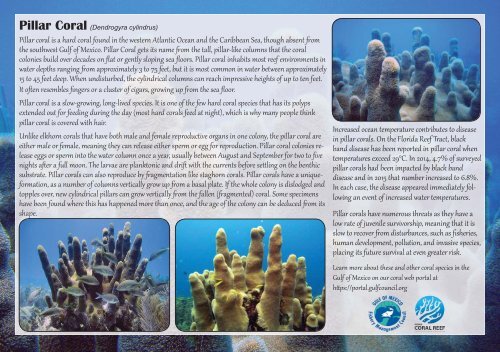ESA Corals From the Gulf of Mexico
Set of pamphlets which highlights basic information about Endangered Species Act (ESA) listed corals from the Gulf of Mexico
Set of pamphlets which highlights basic information about Endangered Species Act (ESA) listed corals from the Gulf of Mexico
Create successful ePaper yourself
Turn your PDF publications into a flip-book with our unique Google optimized e-Paper software.
Pillar Coral (Dendrogyra cylindrus)<br />
Pillar coral is a hard coral found in <strong>the</strong> wester Atlantic Ocean and <strong>the</strong> Caribbean Sea, though absent om<br />
<strong>the</strong> southwest <strong>Gulf</strong> <strong>of</strong> <strong>Mexico</strong>. Pillar Coral gets its name om <strong>the</strong> tall, pillar-like columns that <strong>the</strong> coral<br />
colonies build over decades on flat or gently sloping sea floors. Pillar coral inhabits most reef environments in<br />
water depths ranging om approximately 3 to 75 feet, but it is most common in water beteen approximately<br />
15 to 45 feet deep. When undistrbed, <strong>the</strong> cylindrical columns can reach impressive heights <strong>of</strong> up to ten feet.<br />
It oſten resembles fingers or a cluster <strong>of</strong> cigars, gowing up om <strong>the</strong> sea floor.<br />
Pillar coral is a slow-gowing, long-lived species. It is one <strong>of</strong> <strong>the</strong> few hard coral species that has its polys<br />
exended out for feeding during <strong>the</strong> day (most hard corals feed at night), which is why many people think<br />
pillar coral is covered with hair.<br />
Unlike elkhor corals that have both male and female reproductive organs in one colony, <strong>the</strong> pillar coral are<br />
ei<strong>the</strong>r male or female, meaning <strong>the</strong>y can release ei<strong>the</strong>r sper or egg for reproduction. Pillar coral colonies release<br />
eggs or sper into <strong>the</strong> water column once a year, usually beteen Augst and September for to to five<br />
nights aſter a fll moon. The larae are planktonic and driſt with <strong>the</strong> curents before seling on <strong>the</strong> benthic<br />
substate. Pillar corals can also reproduce by agentation like staghor corals. Pillar corals have a uniqueforation,<br />
as a number <strong>of</strong> columns verically gow up om a basal plate. If <strong>the</strong> whole colony is dislodged and<br />
topples over, new cylindrical pillars can gow verically om <strong>the</strong> fallen (agented) coral. Some specimens<br />
have been found where this has happened more than once, and <strong>the</strong> age <strong>of</strong> <strong>the</strong> colony can be deduced om its<br />
shape.<br />
Increased ocean temperatre contibutes to disease<br />
in pillar corals. On <strong>the</strong> Florida Reef Tract, black<br />
band disease has been repored in pillar coral when<br />
temperatres exceed 29°C. In 2014, 4.7% <strong>of</strong> sureyed<br />
pillar corals had been impacted by black band<br />
disease and in 2015 that number increased to 6.8%.<br />
In each case, <strong>the</strong> disease appeared immediately following<br />
an event <strong>of</strong> increased water temperatres.<br />
Pillar corals have numerous threats as <strong>the</strong>y have a<br />
low rate <strong>of</strong> juvenile surivorship, meaning that it is<br />
slow to recover om distrbances, such as fisheries,<br />
human development, pollution, and invasive species,<br />
placing its ftre surival at even geater risk.<br />
Lear more about <strong>the</strong>se and o<strong>the</strong>r coral species in <strong>the</strong><br />
<strong>Gulf</strong> <strong>of</strong> <strong>Mexico</strong> on our coral web poral at<br />
hs://poral.glfcouncil.org


